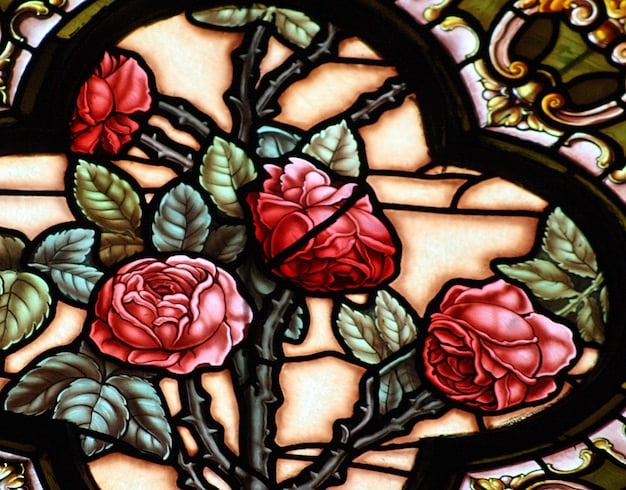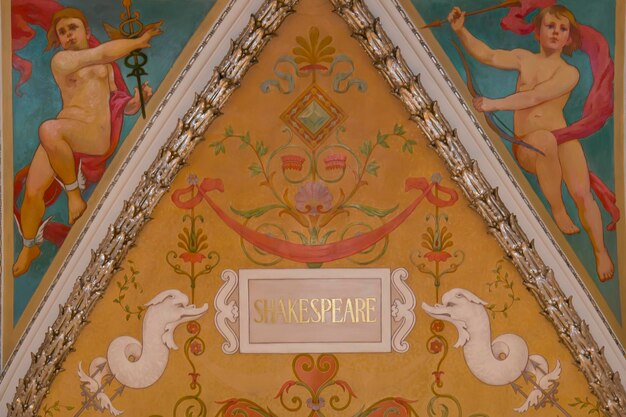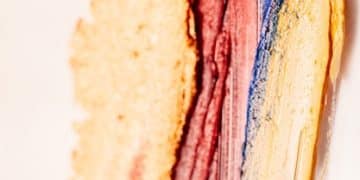Rediscovering the Enigmatic Art of Józef Mehoffer

Józef Mehoffer, a Polish artist active during the Art Nouveau period, is celebrated for his contributions to stained glass, murals, and other decorative arts, yet remains largely unknown to many art enthusiasts outside of Poland.
Have you ever heard of Józef Mehoffer? While celebrated in his native Poland, this fin-de-siècle artist’s work has often been overlooked in broader international art circles. Let’s rediscover the stunning versatility of **Józef Mehoffer**, a master of stained glass, painting, and more.
Józef Mehoffer: A Polish Master of Art Nouveau
Born in Poland in 1869, Józef Mehoffer emerged as a prominent figure in the Art Nouveau movement, leaving behind a diverse portfolio of masterpieces. His artistic journey encompassed not only traditional painting but also ventures into stained glass, murals, and even set design. Let’s embark on a journey to explore the depth and breadth of his contributions.
Early Life and Influences
How did Mehoffer’s early life shape his artistic sensibilities? His formal art education grounded him in academic traditions, yet his exposure to the burgeoning Art Nouveau movement ignited a desire to explore a more decorative and symbolic style.
Academic Training and Artistic Awakening
Mehoffer refined his skills at the Academy of Fine Arts in Kraków and later at the Académie Julian in Paris, absorbing the techniques of renowned masters. These experiences provided the foundation for his later explorations into Art Nouveau. Here are some key influences that steered his development:
- Exposure to Symbolism: This literary and artistic movement emphasized subjective experiences and the hidden meanings behind visible reality.
- Influence of Jan Matejko: Studying under this Polish historical painter instilled in Mehoffer a sense of national pride and the importance of grand narratives.
- Parisian Artistic Currents: Immersing himself in the Parisian art scene exposed him to the latest trends, particularly Art Nouveau’s emphasis on organic forms and decorative elements.
His early training, combined with the influences of symbolism and the Art Nouveau movement, set the stage for his remarkable artistic career. Through meticulous attention to detail and a sense of grand narratives, Mehoffer created some masterful pieces.
Stained Glass Triumphs: The Fribourg Cathedral Windows
Perhaps Mehoffer’s most celebrated achievement lies in his awe-inspiring stained-glass windows for St. Nicholas Collegiate Church, now Fribourg Cathedral in Switzerland. These windows exemplify his mastery of color, symbolism, and narrative, captivating viewers with biblical scenes transformed into dazzling displays of light and art. What makes them so compelling?
A Monumental Commission
Receiving the commission to design the stained-glass windows was a milestone that provided Mehoffer with an unparalleled opportunity to showcase his unique artistic vision. The project spanned several decades and consumed a significant portion of his creative life.
Blending Tradition and Innovation
Mehoffer’s approach ingeniously blended traditional stained glass techniques with Art Nouveau aesthetics, resulting in a captivating fusion of old and new. But how did he manage to balance these elements so effectively?
- Biblical Narratives: Carefully selected moments from the Bible, such as the Nativity and the Crucifixion, provided the thematic backbone for the windows.
- Rich Symbolism: Every detail, from the color palette to the choice of flora and fauna, was imbued with symbolic meaning, enriching the visual experience.
- Art Nouveau Flourishes: The flowing lines, stylized figures, and organic motifs characteristic of Art Nouveau softened the traditional religious imagery, making it more accessible and visually appealing.
The windows of Fribourg Cathedral are not just works of religious art; they are a symphony of light and color, a testament to Mehoffer’s enduring legacy. They mark a pinnacle in his career and cemented his reputation as a master of stained glass.
Painting Beyond Glass: Portraits and Murals
While Mehoffer’s stained-glass windows secured his fame, his talents extended far beyond this medium. He was also an accomplished painter, creating striking portraits and large-scale murals that showcased his artistic versatility. How did these works showcase his range?
Portraits of Polish Society
Mehoffer’s portraits offer a glimpse into the lives of the Polish elite during the late 19th and early 20th centuries. Through his keen eye and masterful brushwork, he captured both the physical likeness and the psychological depth of his sitters.
The “Hamlet” Curtain
Among his notable achievements is the decorative curtain for the Juliusz Słowacki Theatre in Kraków, also known as the “Hamlet” Curtain. This artwork exemplifies Mehoffer’s abilities to blend decorative and thematic elements and to work large-scale. Why is it so significant?
- Symbolic Imagery: The curtain is replete with symbolic imagery, representing themes of tragedy, fate, and human existence.
- Art Nouveau Style: The design exhibits the flowing lines and organic motifs characteristic of Art Nouveau, adding a touch of elegance and sophistication.
- Integration with Architecture: The curtain was designed to complement the theater’s architecture, contributing to the overall aesthetic harmony of the space.
Mehoffer’s forays into painting and murals demonstrate his capacity to adapt his artistic vision to diverse formats. These pieces underscore the breadth of his artistry, solidifying his legacy as a multi-talented exemplar of the Art Nouveau era.

Set Design and the Applied Arts
Mehoffer didn’t confine his creativity to traditional art forms; he also ventured into set design and other applied arts, further demonstrating his versatility. This exploration enriched the aesthetic understanding of everyday environments. In what other ways did he contribute?
Stage Design
Mehoffer designed sets for theatrical productions, infusing his artistic flair into the performing arts. His stage designs enhanced the visual experience for audiences, illustrating how art could elevate theatrical narratives. His set designs were often marked by:
- Innovative Use of Light and Color: Mehoffer experimented with lighting techniques to create atmosphere and mood on stage, enhancing the dramatic impact of the performances.
- Attention to Detail: He meticulously crafted every aspect of the set, from the backdrop to the props, ensuring a cohesive and visually stunning stage environment.
- Integration of Theatrical Elements: Mehoffer’s designs served not merely as background but as an extension of the play’s themes, deeply enriching the audience’s interpretation and emotional engagement.
A Commitment to Gesamtkunstwerk
Mehoffer’s belief in the Gesamtkunstwerk, or “total work of art,” drove him to integrate different art forms, blending painting, sculpture, and architecture into harmonious environments. This philosophy is best showcased in his own home and garden, where every element reflects his artistic vision.
Through stage design and diverse applied arts, Mehoffer demonstrated his expansive view of art’s role in everyday life. His contributions highlight his commitment to aesthetics across various mediums, reinforcing his multi-faceted artistic legacy.
Symbolism and Religious Themes in Mehoffer’s Work
Recurring themes of symbolism and religious narratives permeate Mehoffer’s oeuvre, adding layers of meaning to his art. He often delved into spiritual and philosophical concepts, resulting in thought-provoking works. How did he incorporate these elements?
Biblical Narratives
Mehoffer frequently drew inspiration from biblical stories, reinterpreting them through his distinctive artistic lens. His stained-glass windows in Fribourg Cathedral epitomize this, transforming familiar narratives into visual spectacles that invite deeper contemplation.
Symbolic Language
Mehoffer used symbols extensively to convey complex ideas and emotions. His careful selection of motifs imbued his works with layers of meaning, encouraging viewers to actively engage with the art. Key aspects of his symbolic language include:
- Color Symbolism: Each color was carefully chosen for its symbolic value, enhancing the emotional impact of the artwork; for example, the use of gold could symbolize divinity.
- Floral Motifs: Floral designs were used to represent different aspects of life, love, and spirituality, adding to the visual tapestry of his work.
- Allegorical Figures: Mehoffer frequently employed allegorical figures to embody abstract concepts, such as justice, faith, and hope, making his art both educational and inspirational.
By intertwining symbolism and religious themes, Mehoffer created art that was not only visually appealing but also intellectually stimulating. This ability to evoke deeper meanings ensures that his works continue to resonate with audiences.
Mehoffer’s Enduring Legacy and Rediscovery
Though often overshadowed by his contemporaries, Józef Mehoffer’s artistic contributions are experiencing a resurgence of interest. His unique style and multifaceted talent are gaining recognition once again. Why the renewed attention?
Recent Exhibitions and Retrospectives
Increased exposure through recent exhibitions and retrospectives has introduced Mehoffer’s work to a new generation of art lovers. These events have highlighted the breadth and depth of his artistry, reinforcing his importance in art history.
Preservation Efforts
Efforts to preserve and restore Mehoffer’s works, particularly his stained-glass windows, are ensuring that future generations can appreciate his artistic achievements. These initiatives protect an invaluable cultural heritage. Key preservation efforts include:
- Digital Archives: Creation of digital archives that allow researchers and enthusiasts to access and study Mehoffer’s works from anywhere in the world.
- Restoration Projects: Restoration projects focused on preserving the delicate stained-glass windows and murals, ensuring their longevity.
- Educational Programs: Educational programs designed to raise awareness about Mehoffer’s contributions and encourage further study of his works.
The rediscovery of Józef Mehoffer highlights the enduring power of art to transcend time and cultural barriers. His legacy is safeguarded through new audiences and continual preservation projects, ensuring that his artistry resonates with future generations.
| Key Aspect | Brief Description |
|---|---|
| 🎨 Art Nouveau Style | Known for intricate designs and nature-inspired motifs. |
| ⛪ Fribourg Windows | Stained glass masterpieces at Fribourg Cathedral, Switzerland. |
| 🎭 Set Design | Contributions to theatrical productions and applied arts. |
| 🖼 Portraits and Murals | Talented painter, portraying society and significant events. |
Frequently Asked Questions
▼
Józef Mehoffer is primarily known for his stained-glass windows in the Fribourg Cathedral in Switzerland. These windows showcase his artistic talent and ability to blend traditional and modern art styles.
▼
Mehoffer predominantly worked in the Art Nouveau style, characterized by its use of organic forms, intricate designs, and decorative aesthetics. His work is a prime example of this style’s influence.
▼
Besides his acclaimed stained glass, Mehoffer also excelled in painting, creating portraits and murals. He also ventured into set design for theater and decorative arts, showing his artistic range.
▼
Mehoffer’s most famous stained-glass windows can be seen at the Fribourg Cathedral in Fribourg, Switzerland. These windows are considered his masterpiece, attracting art enthusiasts globally.
▼
Common themes in Mehoffer’s work include symbolism, religious narratives, and elements of Polish culture. His art aims to connect viewers with profound symbolic expressions and historical contexts.
Conclusion
Józef Mehoffer’s artistic legacy extends far beyond his native Poland, capturing the essence of the Art Nouveau era while contributing uniquely to stained glass, painting, and more. By exploring his dynamic fusion of tradition and innovation, one gains a new appreciation for this master’s enduring impact on art history.





